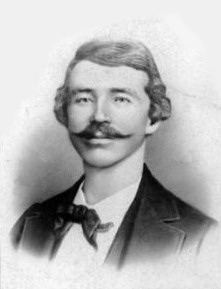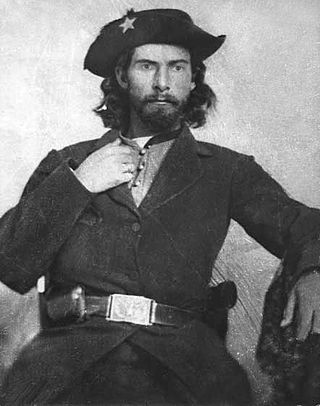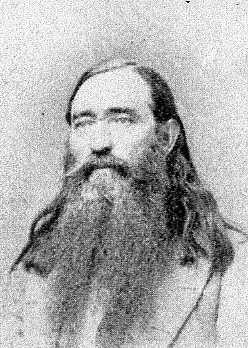
Quantrill's Raiders were the best-known of the pro-Confederate partisan guerrillas who fought in the American Civil War. Their leader was William Quantrill and they included Jesse James and his brother Frank.

William Clarke Quantrill was a Confederate guerrilla leader during the American Civil War.

The Lawrence Massacre was an attack during the American Civil War (1861–65) by Quantrill's Raiders, a Confederate guerrilla group led by William Quantrill, on the Unionist town of Lawrence, Kansas, killing around 150 men and boys.

William T. Anderson, known by the nickname "Bloody Bill" Anderson, was a soldier who was one of the deadliest and most notorious Confederate guerrilla leaders in the American Civil War. Anderson led a band of volunteer partisan raiders who targeted Union loyalists and federal soldiers in the states of Missouri and Kansas.
The Battle of Glasgow was fought on October 15, 1864, in and near Glasgow, Missouri as part of Price's Missouri Expedition during the American Civil War. The battle resulted in the capture of needed weapons and improved Confederate morale, which had been dented after a defeat in the Battle of Pilot Knob.

The Battle of Hartville was fought January 11, 1863, in Wright County, Missouri, as part of John S. Marmaduke's first expedition into Missouri, during the American Civil War.

The Battle of Lone Jack took place during the American Civil War on August 15–16, 1862 in Jackson County, Missouri. The battle was part of the Confederate guerrilla and recruiting campaign in Missouri in 1862.

Price's Missouri Expedition, also known as Price's Raid or Price's Missouri Raid, was an unsuccessful Confederate cavalry raid through Arkansas, Missouri, and Kansas in the Trans-Mississippi Theater of the American Civil War. Led by Confederate Major General Sterling Price, the campaign aimed to recapture Missouri and renew the Confederate initiative in the larger conflict.

Bushwhacking was a form of guerrilla warfare common during the American Revolutionary War, War of 1812, American Civil War and other conflicts in which there were large areas of contested land and few governmental resources to control these tracts. This was particularly prevalent in rural areas during the Civil War where there were sharp divisions between those favoring the Union and Confederacy in the conflict. The perpetrators of the attacks were called bushwhackers. The term "bushwhacking" is still in use today to describe ambushes done with the aim of attrition.

The 12th Iowa Infantry Regiment was an infantry regiment that served in the Union Army during the American Civil War.
The 66th Illinois Veteran Volunteer Infantry Regiment (Western Sharpshooters) originally known as Birge's Western Sharpshooters and later as the "Western Sharpshooters-14th Missouri Volunteers", was a specialized regiment of infantry sharpshooters that served in the Union Army during the American Civil War. The regiment was intended, raised, and mustered into Federal service as the Western Theater counterpart to Army of the Potomac's 1st and 2nd United States Volunteer Sharpshooters ("Berdan's Sharpshooters").
The Enrolled Missouri Militia was a state militia organization of Missouri in 1862 during the American Civil War. It was a part-time force whose primary purpose was to serve as garrison and infrastructure guards, both to augment the Unionist Missouri State Militia in defense versus raids and to free the Missouri State Militia for offensive operations versus Confederate guerrillas and recruiters.
The Battle of Moore's Mill was an American Civil War battle that took place in Central Missouri on July 28, 1862 along Auxvasse Creek near modern-day Calwood. This engagement, the Battle of Kirksville a week later, and the Battle of Compton's Ferry would drive the main Southern recruiters from northern Missouri. The Moore's Mill Battlefield was added to the National Register of Historic Places in 2015.

Upton Hays, sometimes spelled Hayes, was a colonel of the Confederate States Army during the American Civil War.

George M. Todd was an American Confederate guerrilla leader during the American Civil War who served under William C. Quantrill. A participant in numerous raids, including the Lawrence Massacre in 1863, he was ultimately killed at the Battle of Little Blue River in 1864.
On March 7, 1862, Confederate guerrillas under William C. Quantrill raided the small Kansas community of Aubry, southwest of Kansas City, Missouri, and just west of the Kansas-Missouri border. Three residents were killed in the raid and much property was carted away by the guerrillas.

The 23rd Arkansas Infantry (1862–1865) was a Confederate Army infantry regiment during the American Civil War. In the summer of 1864, the unit was reorganized as a mounted infantry regiment in preparation for Price's Missouri Expedition and officially redesignated as the 42nd Arkansas Infantry (Mounted). The unit was often referred to as Lyle's Arkansas Cavalry in report from Price's Missouri Expedition. Due to its mounted status, the unit is also occasionally referred to as the 23rd Arkansas Cavalry Regiment.
The 46th Arkansas Infantry (Mounted) (1864–1865) was a Confederate Army Mounted Infantry regiment during the American Civil War. While authorized by the State Military Board as an infantry regiment, the unit was mounted for Price's Missouri Expedition and served as mounted infantry. Due to its mounted status, the unit is sometimes referred to as the 46th Arkansas Cavalry when a numerical designation is used. The unit is almost always referred to as either Coleman's Arkansas Cavalry Regiment or Crabtree's Cavalry in official reports from the period.
The Ford's Arkansas Cavalry Battalion was a Confederate Army cavalry battalion during the American Civil War.

7th Missouri Cavalry Regiment was a cavalry unit from Missouri that served in the Union Army during the American Civil War. The regiment was formed on 20 February 1862 by merging Bishop's Cavalry Battalion with some unattached cavalry companies. The regiment fought at Independence, Lone Jack, Prairie Grove and Van Buren in 1862. The unit participated in Frederick Steele's expedition to Little Rock in 1863, fighting at Brownsville, Ashley's Mills, and Bayou Fourche. In 1864, the regiment went on the Camden Expedition and fought at Mount Elba and Marks' Mills. The remaining soldiers were consolidated with the 1st Missouri Volunteer Cavalry Regiment on 22 February 1865.













